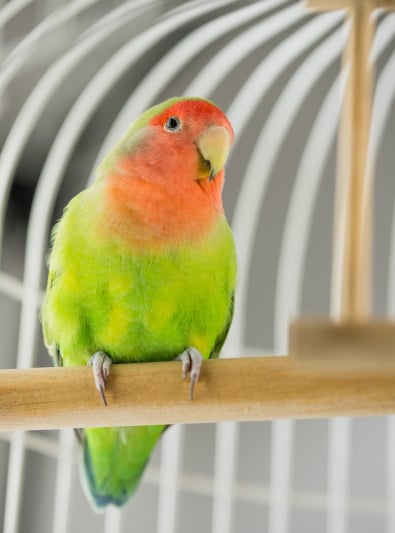Rosy faced Lovebird: displays beautiful colors. If the basic plumage is pale green and blue with an ivory-colored bill, other equally pretty mutations exist. Its name refers to its fidelity, the couples belonging to this species being particularly close.
Another name: Pink-faced Lovebird
Scientific name: Agapornis roseicollis

| Family | Psittacidae |
|---|---|
| Kind | Agapornis |
| Weight | From 43 gr to 63 gr |
| Cut | From 15 cm to 18 cm |
| Rosy faced Lovebird lifespan | From 15 to 20 years oldThe life expectancy of the Pink-faced Lovebird is between 15 and 20 years. |
|---|
Geographical area
The regions of origin of the Pink-faced Lovebird are in Africa, and more precisely in the north of Angola, Namibia (around the Okavango marshes), Botswana, and, to a lesser degree, Zimbabwe.
The rosy faced Lovebird has also been introduced in Arizona, in the western United States, where the environment is fairly close to the geographic areas mentioned above.
This species appreciates savannahs, fields, as well as the proximity of rivers.
History of the breed
The Pink-faced Lovebird was described in 1818 by French ornithologist Louis Pierre Vieillot.
Physical features
The Pink-faced Lovebird is characterized by a pale green body, but with darker shades on the upper areas.
Its name refers to the peach-pink color of the face and the top of the chest. The rump is blue, red eyes, an ivory bill with a black tip, and gray legs.
The green color of the body is paler in the young bird. The final colors appear around the age of one year.
We can find individuals with light pink faces or even mutations type lutino in the wild. In captivity, many other variations exist turquoise, cinnamon, pallid, orange mask, opaline…
Behavior and character

The call generally emitted by the Pink-faced Lovebird is like a shrill “ shreek”. It tends to push it in very rapid succession when it is in danger.
As its name suggests, it evolves mainly as a couple and is extremely linked to its partner, with whom it communicates frequently via a variety of sounds.
A small parrot with very social behavior, the Pink-faced Lovebird can be observed in bands made up of ten or even twenty birds. If the conditions are favorable (food, water points, etc.), the groups can be much larger.
Peach faced lovebird sounds
SOURCE: Video Kameraku
Rosy faced Lovebird Food
The diet of the Pink-faced Lovebird consists mainly of seeds, herbs, and berries.
He must also have fresh water, regularly changed.
Reproduction
In the Pink-faced Lovebird, sexual maturity occurs around the age of 9 to 11 months for the female, and between 11 and 13 months for the male.
The breeding season begins around February or March and ends in July.
There are generally 4 to 6 eggs per laying, the latter often spanning 2 days. Some females may lay more eggs.
The eggs are then incubated by the mother for 22 or 23 days. The chicks fledge around 45 days of age.
Health
The Pink-faced Lovebird is characterized by rather robust health. It even tolerates winter quite well as long as it has a good shelter.
Food and proper care allow this parrot not to fear much in terms of health.
Way of life
The Pink-faced Lovebird needs a sufficiently large cage, the space of which is adapted to the number of individuals. It is important to have their elements allowing the birds to build their nest: grass twigs, branches…
The nest boxes are to be placed in height. The cage is also to be decorated with toys, various perches, feeders, and waterers.
Rosy faced lovebird arizona
SOURCE: SUBBALAKSHMI SASTRY


